Humans and animals differ in the way they use their noses. Living things in the animal world generally use their scent perception to search for food, hunt, communicate amongst themselves, find their way, and to locate their mates and offspring. Birds, mammals, reptiles, fish, insects and other animals have been equipped with the olfactory systems most appropriate for the environments in which they live.
 |
| In the same environment, human beings and dogs will perceive very different smells. Dogs are able to detect many smells that we cannot. |
How did these living things all come by their scent-perception systems? To think that animals themselves constructed the perfect scent-perception systems in their own bodies—or that these perfect systems came into being by chance—is clearly irrational and illogical. Neither living things themselves nor chance can bring together such marvelous systems. Even under the advanced technology of the 21st century and despite all of scientists', researchers' and engineers' best efforts, nothing resembling these marvelous systems can be produced. As for how these living things came by their olfactory systems, there is only one logical reply: Creation.
It is revealed in the Qur'an that we need to learn from the creation of animals:
There is instruction for you in cattle ... (Surat an-Nahl: 66)
And there is certainly a lesson for you in your livestock... (Surat al-Muminun: 21)
 |
| (Moses) said: "Lord of the East and the West, and all between! if ye only had sense!" (Surat ash-Shu'ara': 28) |
The scents perceived by someone walking along the street and their dogs are hardly the same. Dogs obtain a great deal of detailed information about their surroundings from smells of which their owner is quite unaware. They collect information by analyzing scents left by other dogs and the individual scents of nearby human beings. They are able to analyze even the slightest smells in the air.
Dogs’ noses are extraordinarily sensitive: Some breeds’ scent sensitivity is up to a million times that of human beings’.62 A few statistics will help dramatize this special design. In the human nose, the scent region is 5 square centimeters (0.775 of a square inch), but as much as 150 square centimeter (23.25 square in) in dogs.63 And in the canine nose, there are many times more scent receptors. A fox terrier, for example, has 147 million, and a German shepherd, 225 million.64
Thanks to these properties, dogs are able to perform tasks way beyond human beings’ most advanced technological devices. These animals’ superior attributes are used in finding narcotics, contraband, missing people, explosives, criminals and the victims of catastrophes. For example, the bloodhound, a breed with an exceptionally well developed sense of smell, can follow tracks of which there are absolutely no visible traces. They can follow a track for as much as four days65 and follow the tracks left by a human for 80 kilometers (49.7 miles).66
Strikingly, dogs do not make mistakes, despite the countless number of scents in their world. They are easily able to distinguish the particular smell they are looking for. Experiments have shown that a trained dog is able to locate what was expected of it from among items covered with highly pungent skunk scent.67
The Schlieren photography technique revealed that dogs used a different method of inhalation: a dog smelling something twitches its nose when exhaling, and the air heads directly towards the two clefts on either side. Thanks to this special design, the dog's exhaled air flows in a different direction, and the air in its breath is thus prevented from combining with the scent.68
 |
| Such dogs are used to rescue survivors from ruins, and German Shepherds are trained as police dogs. |
 |
| With their highly sensitive noses, dogs' sensitivity to smell is 1 million times greater than human beings'. |
Researchers are still trying to develop new devices by unraveling the complex analysis performed in the canine nose and brain.69 There is presently a great need in the day for such devices, especially for detecting bombs, mines and various dangerous substances. However, the devices that have been produced so far come nowhere near matching the scent sensitivity of dogs.
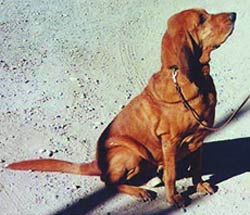 | 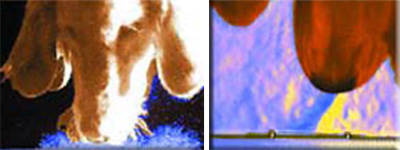 |
| The breed of dog known as the bloodhound. | A photograph showing dogs’ inhalation and exhalation, taken using the Schlieren technique. |
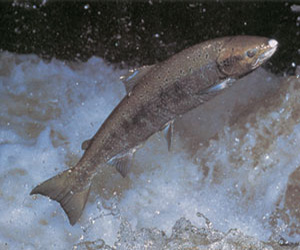 |
Scent perception is important to just about all fish species.70 The scent perceiving region is located on the rear surface of their noses. They find food by following scent molecules dissolved in the water. In addition, their sense of smell warns them of danger: Fish that detect the smell of an injured fish immediately go on the alert.
A shark possesses nostrils much like those of human beings, but it uses them only for smelling. When swimming, it analyses the molecules that enter its nostrils. Approximately one-third of its brain is devoted to smell.71 The scent perception mechanism in sharks is totally unique to them, enabling them to follow a smell to its point of origin. They can detect the scent of a drop of blood in the sea or the very tiniest amounts of chemical substances from other creatures. For example, they can detect the smell of ten drops of tuna odor in a swimming pool full of water.72
Eels are also exceedingly sensitive to odors. An eel can detect the smell of a thimbleful of a chemical substance poured into a large lake.73
Salmon are one of those fish whose senses of smell have been most intensively researched.
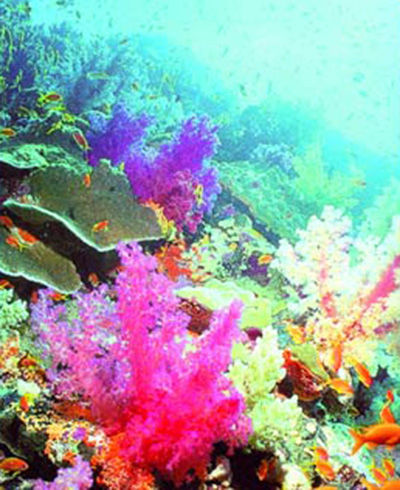 |
| It is Allah Who has subjected the sea to you, that ships may sail through it by His command, that ye may seek of his Bounty, and that ye may be grateful. (Surat al-Jathiyya, 12) |
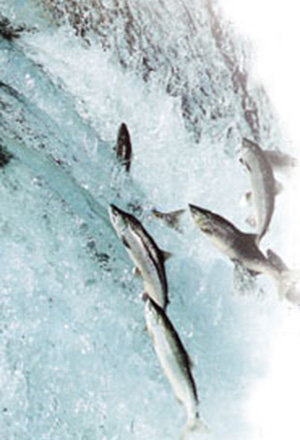 |
The word migration generally reminds one of the way birds change location on a semi-annual basis. Yet there are other creatures that migrate on land and sea, as well as just in the air. Young salmon hatch from their eggs in rivers at the end of winter. Some species migrate to the open waters and the sea immediately after hatching, others do so after feeding for a few weeks, and still others after spending a few years in the river. Salmon that have spent a few years in the oceans and reached reproductive maturity now engage in a journey that astonishes human beings.
On this journey, the salmon’s objective is to return to the stream where it hatched, and lay its own eggs there. This journey is very much harder than the first one, because the salmon must swim up against the powerful flowing current and leap up over cliffs and waterfalls. Every salmon travels hundreds or even thousands of miles to reach the river or branch where it hatched.74 Red salmon travel more than 1,609 kilometers (1,000 miles) in the sea and rivers.75 King salmon and dog salmon swim for more than 3,218 kilometers (2,000 miles) in the Yukon River.76 Atlantic salmon repeat this migration every year, while other species performing it only once.
In making this long and wearying journey, the salmon has no navigational aids such as map or compass to help it find its way. Even though it has no training, it has no difficulty in finding the mouth of the river it swam down in its youth, and from many river branches, unerringly selects the one that will lead it back to where it was born. The salmon achieves these seemingly impossible tasks because it possesses a perfect scent perception system that functions as a directional locater.
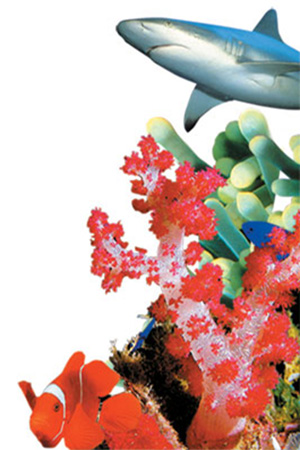 |
These abilities of salmon were first revealed by experiments carried out in the 1970s. Allan Scholz of Eastern Washington University exposed salmon to one of two odorant chemicals, then tagged the fish and released them. Two years later, when the time came for these salmon to spawn, he scented one of the nearby river branches with one of the scents and another branch with the other scent. The salmon were observed to return to whichever branch contained the scent they had been exposed to when young.77
The salmon possesses a dual-nostril nose. Water enters through one nostril and exits through the other. These holes have been so designed as to open and close in synchronization with the fish's breathing. In this way, the salmon can immediately analyze scent molecules dissolved in the water. It perceives the characteristic scent of every individual tributary, which odor stems from plants, animals and soil, and completes its journey by comparing these with the scent memory it recorded on its journey to the sea when young.78 In short, the fish's sense of smell serves to guide it on its journey of thousands of kilometers (miles).
No doubt the sensitivity of the salmon's sense of smell is one of the countless proofs of the splendor in God's creation. In one verse, God reveals:
Among His Signs is the creation of the heavens and Earth and all the creatures He has spread about in them. And He has the power to gather them together whenever He wills. (Surat ash-Shura: 29)
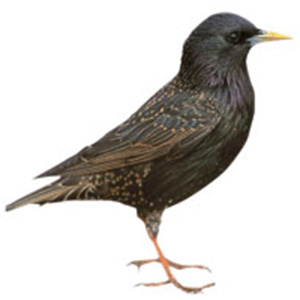 |
| A starling |
Up until around 30 years ago, the general scientific view was that birds could smell almost nothing at all. But it later emerged that this was not the case. Research showed that birds did perceive smell, despite having a seemingly small olfactory bulb in their brain. Birds use their sense of smell while searching for food, selecting nesting materials and even when flying over featureless land with which they are unfamiliar.79 Following are the results of various studies by bird and scent experts.
Some species of vulture determine their prey by the smell it emits. Vultures have even been observed to fly repeatedly over areas where there are leaks in gas pipelines. The reason for this behavior is not hard to guess. Vultures detect the smell of a chemical additive in gas, which closely resembles that of dead carrion.
Different species of pigeon possess different-sized scent perception regions and olfactory bulbs. Laboratory experiments have also shown that every bird displays a specific reaction to smells. Homing pigeons, which can return to their roosts even after being released from a long distance away, use their sense of smell as well as sight. It has been proven many times that if pigeons' sense of smell is obstructed by blocking their nostrils, they fail to return home. Pigeons are thought to use mainly visual indicators when near their roosts, and scents borne by the wind when they are in unfamiliar territory. (In addition, pigeons may also find their way by sensing the Earth's magnetic field.)
When building their nests, European starlings select by means of smell plants that will minimize the occurrence of harmful micro-organisms and parasites.
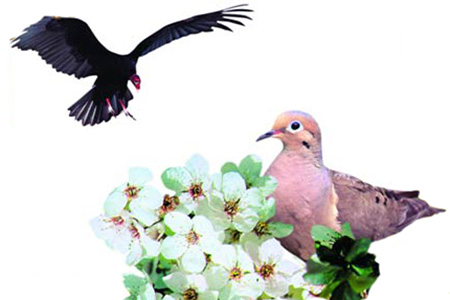 |
| Above: A vulture that locates food from the smell it gives off. Side: A pigeon able to travel long distances back to its nest, also by using its sense of smell. |
The sources of food of birds living near the South Pole frequently change location. There are also very few visual indicators to help pinpoint them. For birds living in this region, finding their prey with eyesight is like searching for a needle in a haystack. However, polar birds have been created with a special sense of smell that allows them to locate their prey under the harsh conditions of the South Pole by following its scent.80
Experts say that further research and experiments must be carried out in order to understand the details of the avian sense of smell. No doubt new scientific studies will reveal still more marvels in birds' sense of smell. The divine signs in birds are revealed in these words in the Qur'an:
Do they not see the birds suspended in mid-air up in the sky? Nothing holds them there except God. There are certainly Signs in that for people who believe. (Surat an-Nahl: 79)
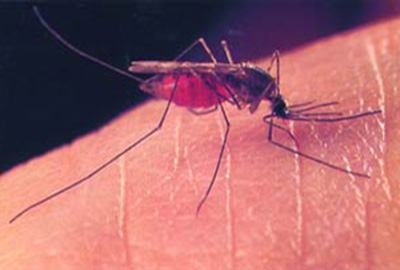 |
| The gnat is one of the living things referred to by God in the Qur'an. |
Could you find the origin of a scent 64 kilometers (39.8 miles) away by using only your sense of smell? Of course not! It’s impossible for you to detect a scent from so far away. Yet mosquitoes detect smells at an analogous distance, which would be out of the question for you.81
This fact was discovered by Professor Jerry Butler of Florida University. As is well known, for her eggs to develop, the female mosquito needs blood as well as certain chemical substances including cholesterol and Vitamin B that she cannot manufacture herself. These she obtains from human beings or animals. Professor Butler’s studies revealed that the female mosquito does not select at random the prey whose blood she will suck. She prefers creatures that will meet her needs in the best possible way and in particular, uses her sense of smell to locate them. According to Butler, mosquitoes’ sense of smell is so specialized that they can identify the minute amounts of chemicals that the human body gives off into the air.82
Smells originating from the human body, carbon dioxide given off during exhalation and other scents are constantly disseminated into the air. The female mosquito is equipped to detect them, and finds her prey by zigzagging among the scent molecules, then locating the location of a surface artery, using a heat detector with pinpoint accuracy.
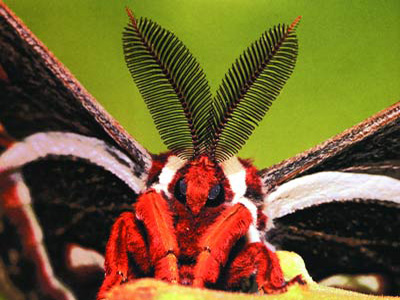 |
| Thanks to the special creation in their antennae, which have hundreds of minute hairs on them, moths have very powerful senses of smell. This enables them to identify foodstuffs with a high nutritional value, as well as potential mates. |
The way that an insect 1 centimeter (0.4 inch) in length smells her prey from many meters (feet) away and also analyses that scent, is a most striking phenomenon. The mosquito’s highly developed olfactory sense is just one of the magnificent pieces of equipment in its body—and an important fact of creation that once again allows humans to realize the flawless nature of God’s creation. The sense of smell in the mosquito, which many people regard as an unremarkable insect, is just one of the countless proofs of creation.
It is revealed in the Qur’an, as follows:
God is not ashamed to make an example of a gnat or of an even smaller thing. As for those who believe, they know it is the truth from their Lord. But as for those who disbelieve, they say, "What does God mean by this example?" He misguides many by it and guides many by it. But He only misguides the deviators. (Surat al-Baqara: 26)
There is only one explanation for the perfect sense of smell possessed by the mosquito, its superior flight mechanism and its other systems. This insect, encountered every day in warm weather but so often underestimated, is full of miracles of design and is by itself a major proof of creation. In Surah Al-Hajj, God reveals:
O humanity! An example has been made, so listen to it carefully. Those whom you call upon besides God are not even able to create a single fly, even if they were to join together to do it. And if a fly steals something from them, they cannot get it back. How feeble are both the seeker and the sought! (Surat al-Hajj: 73)
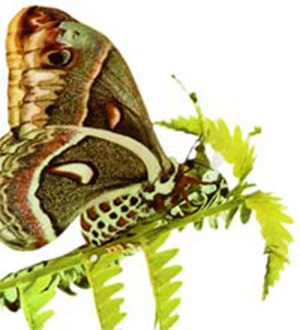 |
Moths are insects that live on every continent, apart from the Polar Regions and the oceans, and there are thought to be up to a million different species.83 The two antennae on the head of this tiny creature serve as its olfactory organs. Each antenna is covered in hundreds of minute hairs, with scent-receptor cells on each hair. This special design of its antennae makes the moth quite expert in detecting smells.84
Moths use their scent perception to determine what has nutritional value and what may be harmful. In addition, when mating time comes, the female emits a special pheromone, which the male detects and locates the female by flying directly towards its source. At this point, there is one matter that requires consideration. The male often flies for several kilometers (miles) to locate the female. Male silk moths, for example, can perceive the female’s pheromone from 20 kilometers (12 miles) away, or even further.85 No doubt the sensitivity of this tiny creature’s olfactory organs is truly stunning.
But how is a male moth able to locate the female of its own species from among the thousands of different species of moths in its region? The moth’s sensitive sense perception helps answer that question. The moth's sensitive sense perception helps answer that question. To cite one example: the male of Helicoverpa zea, a species of moth that lives in North America, can distinguish the source of two different pheromones less than 1 millimeter (0.04 inch) apart.86
Researchers have performed various experiments by installing minute receptors on moths' antennae—in other words, on their olfactory organs.87 As the male moth flew towards a pheromone inside a tunnel, electrical signals transmitted by its antennae to its brain were recorded. It was observed that as soon as the moth encountered a cloud of pheromones, the signals from its antennae changed.
C. Giovanni Galizia of the University of Berlin states that the moth's scent- perception system may be most ideally suited to detecting smells in powerful winds.88 This perfect system in an animal just a few millimeters (inches) in size is an evident miracle of Creation.
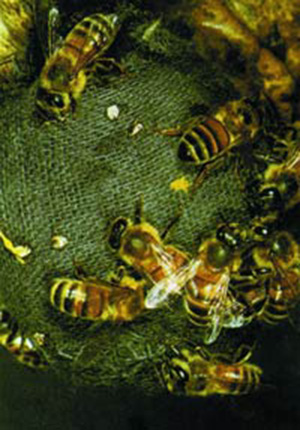 |
| Bees are able to identify by scent bees that do not belong to their hive. |
Pheromones are one of the methods by which bees communicate among themselves. The tens of thousands of bees in a colony use these chemical signals to communicate with one another. (Ants communicate in a similar way.) Bees recognize other members of their own colony by their distinctive scent. If a bee from another hive seeks to enter, it is immediately identified by its scent and ejected. Having consumed the last of a flower’s nectar, the bee marks it with a special scent— which other bees can then detect and thus avoid wasting their time and energy.
Every bee possesses an olfactory system to detect the messages borne by pheromones. Their scent receptors are located in the antennae. Sathees Chandra, a researcher into bees, states that when it comes to scent detection, bees are very capable.89 Bees need nectar in order to make honey. For that reason they visit a great number of plants and soon learn which provide the most nectar.90
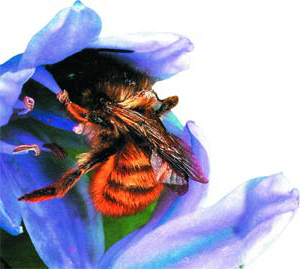 |
Bearing this in mind, scientists concluded that bees must have special mechanisms that allow them to identify plant scents.91 Thanks to this mechanism, they filter the information they receive from plants and determine which will offer them the most nectar. There is only one explanation for the conscious and rational behavior of these tiny insects’ detecting scents. Like all living things in the universe, bees were brought into being by the will of God, and behave according to His inspiration.
This is revealed in these terms in the Qur’an:
Your Lord revealed to the bees: "Build dwellings in the mountains and the trees, and also in the structures which men erect. Then eat from every kind of fruit and travel the paths of your Lord, which have been made easy for you to follow." From inside them comes a drink of varying colors, containing healing for humanity. There is certainly a Sign in that for people who reflect. (Surat an-Nahl: 68-69)
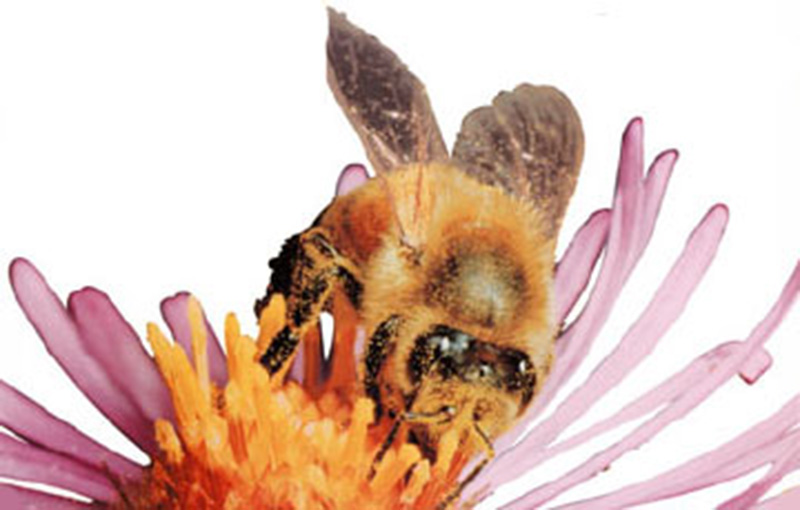 |
62. Norma Bennett Woolf, “The nose knows: Canine scents and sensibilities,” 2001,: http://www.canismajor.com/dog/nose.html. ![]()
63. Eric Chudler, “Amazing Animal Senses,” 2001,: http://faculty.washington.edu/chudler/amaze.html ![]()
64. “K9 Olfactory System—Theory of Scent,” Eden & Ney Associates Inc., 2000, http://www.policek9.com/Trainers_Digest/theory/body_theory.html ![]()
65. “Domestic Dog,” M. Encarta Encyclopedia 2000, Deluxe Edition CD ![]()
66. “Bloodhound,” M. Encarta Encyclopedia 2000, Deluxe Edition CD ![]()
67. L. Wilson Davis, Go Find! Training Your Dog To Track, New York: Howell Book House, 1974. ![]()
68. Mark Schrope, “Sniffing danger,” New Scientist, 26 August 2000. ![]()
69. Joanne Cavanaugh Simpson, “Building better sniffers,” Johns Hopkins Magazine, November 1999. ![]()
70. “Fish: Olfaction,”Britannica CD 2000 Deluxe Edition CD ![]()
71. “Shark,”M. Encarta Encyclopedia 2001 Deluxe Edition CD ![]()
72. “Shark Attack!, The Hunt, Smell,” NOVA Online, 2001,: http://www.pbs.org/wgbh/nova/sharkattack/hotsciencesharks/sensesmell.html ![]()
73. “Super Senses,” World Magazine, National Geographic Society, June 2000. ![]()
74. “Salmon (fish),” M. Encarta Encyclopedia 2001 ![]()
75. “Sockeye salmon,” Britannica CD 2000 Deluxe Edition. ![]()
77. Marcia Barinaga, “Salmon Follow Watery Odors Home,” Science 286, 22 October 1999, pp. 705-706. ![]()
79. David Malakoff, “Following the Scent of Avian Olfaction,” Science 286, 22 October 1999, pp.704-705. ![]()
81. “Mosquitoes have discriminating tastes,” CNN Environmental News Network, 26 August 1999,: http://www.cnn.com/NATURE/9908/26/mosquitoes.enn/index.html ![]()
82. “Mosquitoes use super senses,” BBC News, 21 August 1999, http://news.bbc.co.uk/hi/english/sci/tech/newsid_426000/426655.stm ![]()
83. “Butterflies and Moths,”M. Encarta Encyclopedia 2001. ![]()
84. Bente Haarstad, “Insects’ amazing sense of smell,” January 1998, http://www.ntnu.no/gemini/1998-01E/30.html ![]()
85. “Butterflies and Moths,” M. Encarta Encyclopedia 2001. ![]()
86. T.C. Baker, H.Y. Fadamiro, and A.A. Cosse, “Moth uses fine tuning for odour resolution,” Nature 393, 11 June 1998, p.530. ![]()
87. Neil J. Vickers, Thomas A. Christensen, Thomas C. Baker, and John G. Hildebrand, “Odour-plume dynamics influence the brain's olfactory code,” Nature 410, 22 March 2001, pp.466-470. ![]()
88. Helen Pearson, “Sniffing out smell’s secret code,” Nature Science Update, 22 March 2001, http://www.nature.com/nsu/010322/010322-12.html ![]()
89. Sara Abdulla, “Getting up bees’ noses,”Nature Science Update, 12 November 1998, http://www.nature.com/nsu/981112/981112-9.html ![]()
90. Jessa Netting, “What's in a smell?,” Nature Science Update, 15 September 2000,http://www.nature.com/nsu/000921/000921-2.html. ![]()
91. J.S. Hosler and B. H. Smith, “Blocking and the detection of odor components in blends,” Journal of Experimental Biology 203, 2000, pp. 2797-2806; Jessa Netting, Op cit. ![]()